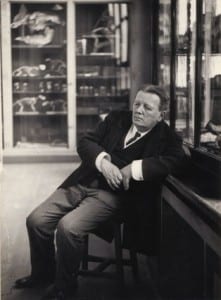An imaginary conversation with our former curator
By Jack Ashby, on 19 December 2012
 In his role as Professor of Zoology and Comparative Anatomy at UCL from 1875-1890, E. Ray Lankester was responsible for the collection which we now call the Grant Museum of Zoology. Lankester was an extremely influential figure in evolutionary biology, and after UCL went on to a professorship at Oxford and then to direct the Natural History Museum. Something else that people like to say about him is that he was described as having “a head like a benevolent biscuit tin”.
In his role as Professor of Zoology and Comparative Anatomy at UCL from 1875-1890, E. Ray Lankester was responsible for the collection which we now call the Grant Museum of Zoology. Lankester was an extremely influential figure in evolutionary biology, and after UCL went on to a professorship at Oxford and then to direct the Natural History Museum. Something else that people like to say about him is that he was described as having “a head like a benevolent biscuit tin”.
When you visit the Grant Museum today you’ll see his influence all over the place – he put together the first formal cataloguing system (though his catalogue is a bit confusing as it includes labels for specimens he wanted to acquire as well as things that actually existed, and there is no way of telling which is which). Although he brought so many specimens into the Museum (including the famous Blaschka glass models), his most famous specimens are of the horseshoe crabs. He used the dissected specimen on display to demonstrate that they were related to arachnids, rather than crabs.
Why am I talking about Lankester? Professor Roger Wotton, who gave the Grant Lecture last year, has recently won an award for his research which resulted in an imaginary conversation between Lankester and a new academic, set at the start of the 20th Century.
It begins…
New Academic: Sir Ray, you are recognised as a major figure in the History of Biology – as a scientist, teacher, Head of Department, and populariser of Science. When did your interest in Biology begin?
Professor Sir Ray Lankester: I inherited it from my father. Well, not inherited exactly, but directly as a result of his influence and that of his friends. He was trained in Medicine, at University College London, actually, but retained a passion for Science. Visits of his friends to our house nurtured my enthusiasm further and I remember the Natural Historian P.H.Gosse, who shared my father’s love of microscopy, Charles Darwin, T.H. Huxley and many others. I, too, developed an interest in looking through microscopes and I still have it today. There was, of course, much conversation to listen to when I was allowed to be involved, and my father was always busy with papers for the Quarterly Journal of Microscopical Science, which he edited. It was a great honour that I succeeded him in that role.
It’s well worth a read and can be found here: http://www.ucl.ac.uk/research-frontiers/contest/wotton.pdf
This excerpt mentions Lankester’s father’s friend Philip Henry Gosse (whose paintings of marine life form an inspiration for many of the Blaschka glass models). I’d also like to mention that Roger Wotton has just published a book Walking with Gosse: Natural History, Creation and Religious Conflicts. In the book Roger gives a remarkable insight into the world of Philip Henry Gosse. By interweaving historical biography with his own life as a natural historian raised as a Christian, Roger conveys an intuitive and intimate understanding of his subject’s struggles. Walking with Gosse has much to say about contemporary attitudes to living things, to debates about creation, and to the causes of religious conflicts. You can find an order form here: https://blogs.ucl.ac.uk/museums/files/2012/12/WWG-flyer.pdf
 Close
Close

